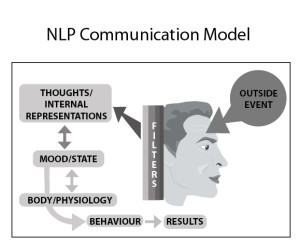Let’s start with a quick look at what NLP actually is,
 and where it came from. In the early 1970s, a linguist, John Grinder, and a mathematician, Richard Bandler, studied individuals who were excellent communicators and technicians of personal change.
and where it came from. In the early 1970s, a linguist, John Grinder, and a mathematician, Richard Bandler, studied individuals who were excellent communicators and technicians of personal change.
“What is the difference between somebody who is merely competent and somebody who excels at the same skill?” was the question they asked. The answers produced NLP: The Science of Excellence…The Art of Change.
They began by modelling world-class therapists. Later they moved onto other fields, including sales people, presenters, trainers and leaders. By closely studying and modelling the beliefs, behaviours and strategies of these models of excellence, they were able to install that behaviour in themselves. As a result of this work, Bandler and Grinder formalised their modelling techniques and their own individual contributions under the name ‘Neuro Linguistic Programming’ – known as NLP – to symbolise the relationship between the brain, language and the body.
Unlike other approaches that tell you WHAT you need to do, NLP is a HOW TO technology. It tells and shows you HOW TO be what you want to be, have what you want to have and do what you want to do. An intoxicating combination. This means it is possible to have the personal success you want now! For most people things happen and they react. NLP offers a better way. It gives you tools to react differently by choice, to be more aware of your thoughts, feelings and behaviour. You are then ready to take responsibility for your results in all areas of your life.
NLP provides a set of tools and techniques to help you deal with unhelpful patterns of thought and behaviours. Although there are many techniques in NLP you can make amazing changes by using just one technique. Let’s look at each part of NLP in turn:
Neuro
Neuro is all about what we THINK – or our THOUGHTS.
Neuro means ‘what goes on inside our heads’. We have over 60000 thoughts a day. These form our internal world of pictures, sounds and feelings. It is these conversations, dialogues or arguments we have with ourselves in our thinking process that drive how we feel, our mood and ultimately how to respond to events. In NLP terms these are called our internal representations. For example, if you open your curtains on a miserable rainy day you may as a consequence feel lousy and this will drive how your day goes for you. Alternatively you can open the curtains and think to yourself ‘it’s a brilliantly rainy day today!’ and go off and have fun. Another example would be if you are getting ready for an important night out – maybe with a potential new partner – you are excited and focused on the evening going well and how you will feels as a result. This will impact directly on the success of that meeting.
The critical point to realise is that we can control our thoughts. This is very important because how we feel, how we behave and ultimately the results we get are driven by combinations of these internal representations which form our repeating patterns or habits. We run these patterns or habits over and over again unless they are interrupted or redirected. Sometimes these patterns serve us well but often they sabotage our potential success. The trick is to ensure that the 60000 thoughts you have every day are good ones! Work out for yourself what proportion of your thoughts are helping you to achieve what you want and what proportion are in some way keeping you stuck.
Linguistic
Linguistic is all about what we SAY, both verbally and non-verbally
Language determines how we communicate with other people and ourselves. It is how we label our experience and much more. Empowering language generates empowered behaviour. Likewise, negative language, such as excuses, is the result of disempowering thoughts and often happens without our realizing it. It’s negative language that limits our choices.
It is estimated that 93% of communication is non-verbal. This means how you say what you say (intonation, volume, speed, etc.) carries five times more information than the words spoken. And how you use your body (gestures, facial expressions, posture) is even more influential. As our thoughts and feelings literally ‘leak’ out of us through our bodies, consider what yours says about you? Do they portray low self-esteem or someone who has confidence and knows what they want?
Programming
Programming is all about what we DO.
We are all running programmes in our minds, all of the time. These programmes, patterns of behaviour and strategies drive the way we behave, our performance and ultimately our results. A phobia is a good example of how the brain works. A particular situation or trigger, such as flying, produces a strong physical response (sweaty palms, fast breathing, panic, etc). The brain learns quickly and thereafter, every time the person is presented with the same stimulus, their body knows to have the same response. The amazing thing is, people with phobias NEVER forget to have this response. This is the perfect one-time learning strategy! Often, as with phobias, you run strategies that do not serve – they even sabotage you. NLP teaches us how to change these ineffective strategies or programmes for ever.
To bring it altogether, NLP symbolises the relationship between the brain, language and the body. It describes how what we say, think and do interplay and affect our body and our behaviour and our results.
If you’d like to learn more about NLP please visit our shop where you can access all Lindsey’s books on NLP
